ASUS G73Jw: Out with the Old, In with the New
by Jarred Walton on November 3, 2010 12:33 AM ESTASUS G73Jw: Application Results
We’ve already seen i7-740QM in the Toshiba A665-3DV, so there’s not much new here. Intel’s quad-core Clarksfield chips are the fastest mobile processors in the market for the time being—at least until Sandy Bridge arrives. The flipside is that Clarksfield isn’t particularly power-friendly, so with the high performance comes poor battery life. ASUS does tend to tweak their systems a bit better than other vendors, so general performance (even with a conventional hard drive) is quite good.
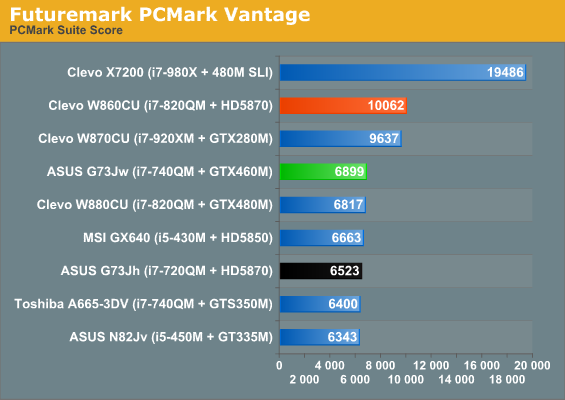

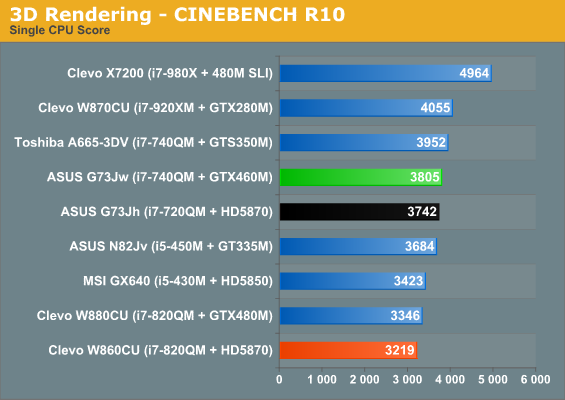
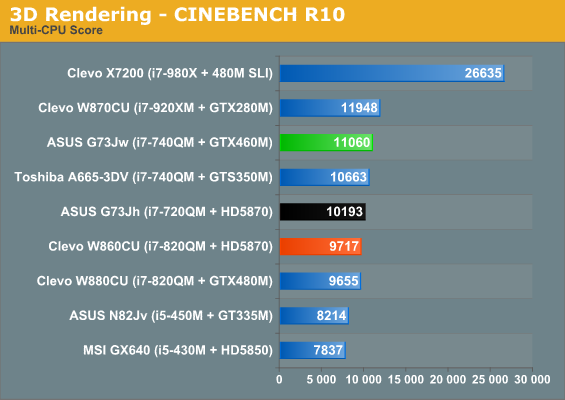
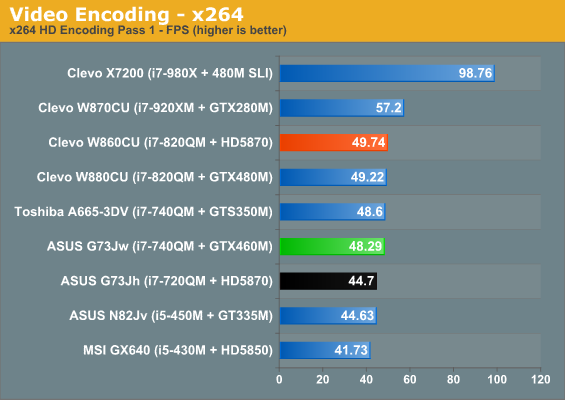
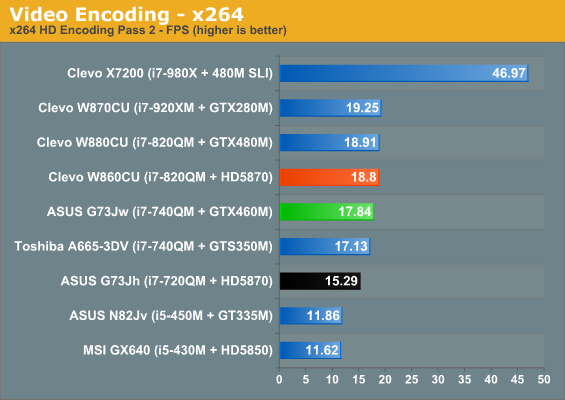
The G73Jw is faster than the similarly equipped A665-3DV in nearly every test, with a particularly large gap in PCMark05. The SSDs in some of the other notebooks provide a massive boost to performance in PCMark, but otherwise the G73Jw falls right in line where we’d expect. It’s also clearly faster than the original G73Jh (8% faster on average, right in line with the clock speed improvement), though the updated version should be the same. Turbo Boost means the i7-740QM is faster in virtually every instance relative to the dual-core Arrandale parts. We don’t have all the parts in the above charts, but even an i5-540M (2.53GHz with up to 3.07GHz Turbo) struggles to establish a clear lead over the 740QM in lightly thread applications; switch to heavily threaded applications and there’s simply no contest.
The only ingredient really missing from the G73 right now is a good SSD to help improve overall responsiveness. With two 500GB hard drives, there’s room for a ton of games, movies, pictures, etc., but we could say the same of a single 500GB drive. Had ASUS gone with a reasonable 80GB SSD for the OS and applications, the price wouldn’t be substantially higher but many tasks would be snappier. Maybe when we get the next generation SSDs with 25nm NAND, prices will reach the point where a decent 80GB SSD will cost as much as a 500GB 7200RPM and ASUS can make the switch. Time will tell, but as far as general performance goes an SSD is the next logical step.










53 Comments
View All Comments
mhorn - Wednesday, November 3, 2010 - link
Great article. Are there any plans to do a review of the G53JW that just came out since it's a smaller version of the G73JW but what looks to be a big upgrade over the G51JX?Kaihekoa - Wednesday, November 3, 2010 - link
What's with all the laptop articles? There's one every few days which lately is much more often than desktop hardware. There are a dozen different components to a desktop with dozens of suppliers - how about some reviews on cases, power supplies, coolers, displays, etc. I barely visit Anandtech anymore because i seems like the only time I see a hardware review is for a major release from AMD/Intel/Nvidia/ATI.trengoloid - Wednesday, November 3, 2010 - link
the g73jw Price 1,745.03 compare to g73jw-xa1 for the price of $1,449.00 it's $300 cheaper than the g73jw and the only difference between the two is the blueray disk and 250gig and 1 year warranty and bag and mouse but remember you can upgrade theg73jw-xa1 for a better spec than the g73jw like buy a bag and mouse for just $50 and buy a hdd 1.5 gig for just &78 and external blueray drive for $90so you get the external blue ray and the built in super dvd drive. there's a lot of upgrade you can do for the price of $300 :)
Wolfpup - Wednesday, November 3, 2010 - link
It's 1120 cores, and the performance does suffer from it. If they do a mobile part, I'd expect it to be chopped down too-probably less than 800 cores. Either way I wouldn't expect it to be better than today's AMD part.JarredWalton - Wednesday, November 3, 2010 - link
Oops... corrected. I got the 5770 core count mixed up with the 6870 and somehow thought they were both 800. I've edited the final paragraph to correct the information, but ultimately the percentages are still what matters. The Northern Islands GPUs improve shader core efficiency at the same power envelope, so one NI core is worth more than one Evergreen core. Anyway, the point is that I'm not really satisfied with mobile GPU performance, at least not at the top-end.We're at less than half of what the top desktop parts can do for both AMD and NVIDIA, and I want something more than that. 5870 has 1600 cores at 850MHz and 153.6GB/s of bandwidth while Mobile 5870 has 800 cores at 700MHz with 64GB/s of bandwidth. 480 has 480 cores at 1401MHz (700MHz for the non-shader stuff) with 177.4GB/s, but 480M has 352 cores at 850MHz (425MHz non-shader) and only 76.8GB/s. That means the best single AMD mobile GPU has roughly 41% of the computational power and bandwidth; the best single NVIDIA mobile GPU has 43-45% of the computational power and bandwidth.
Yes, they also use under half the power, but Intel manages to make a mobile CPU that has about 65% of the performance of its desktop counterpart and uses less than half the power. That's the bar I want to see mobile GPUs reach: two-thirds the performance, less than half the power. Binning already gets a lot of that, so a few tweaks and refinements ought to get the rest. :-)
trengoloid - Wednesday, November 3, 2010 - link
the g73jw Price 1,745.03 compare to g73jw-xa1 for the price of $1,449.00 it's $300 cheaper than the g73jw and the only difference between the two is the blueray disk and 250gig and 1 year warranty and bag and mouse but remember you can upgrade theg73jw-xa1 for a better spec than the g73jw like buy a bag and mouse for just $50 and buy a hdd 1.5 gig for just &78 and external blueray drive for $90so you get the external blue ray and the built in super dvd drive. there's a lot of upgrade you can do for the price of $300 :)
JarredWalton - Wednesday, November 3, 2010 - link
Just to clarify a few things that you're glossing over:The mouse in the G73Jw is far nicer than a cheap $20 optical... it uses the new HP Voodoo gaming mouse, only with a different coating (to match the G73 "stealth" coating). Best price you can find for this sort of mouse is around $40-$50.
As for the bag, even a rather generic backpack is going to cost at least $30, and I'd probably value this one at $40 or more.
The single 750GB HDD looks like it's the Seagate ST9750420AS (about $120), compared to two 500GB Seagate drives ($66 each), so that's a wash really but I suppose it makes adding an SSD easier (if you can find a caddy). FWIW, the only perfect fit for the caddy right now appears to be [l=this one]http://www.asusparts.eu/product_info.php?cPath=676...[/l]. Yup, that's almost $40 for a stupid little metal tray!
Then there's the Blu-ray/DVDR combo drive. Those go for $140, not $90 (unless you just want Blu-ray and DVD reading, with no recording capabilities or you buy a refurbished/used drive).
Add all that up and the difference in price for the mouse, backpack, and BD-Combo alone is at least $220, or $260 if you count the cost of a drive caddy.
We're then left with the final item you neglected to mention: the 1-year versus 2-year warranty. I can easily see the extra year of warranty being worth $100.
So in summary, the XA1 isn't "better" and there's no "truth" behind this (thanks for the double post by the way); it's simply another option where you get exactly what you pay for. The A1 comes with all the extras for $300 more, or you can get the stripped down model with $350 less of "stuff".
JarredWalton - Wednesday, November 3, 2010 - link
Hmmm... links no longer work? Let's try again, as maybe I had the format wrong. [l=http://www.asusparts.eu/product_info.php?cPath=676...]HDD caddy[/l]XiZeL - Wednesday, November 3, 2010 - link
ohh cmon asus 60gig sandforce SSD's are so cheap now why put in 2 hard drives when you could put an SSD for system and other for storage.gc_ - Wednesday, November 3, 2010 - link
Here's a couple errors, please correct me if not:1. Table caption on first page (!)
actual: "ASUS G73Jh-A2 Specifications"
expect: ASUS G73JW-A1 Specifications
2. Battery life on fourth page
"Idle battery life improves by 49%, Internet battery life is up 26%, and x264 playback is UP 41%."
But the graphs and numbers tell a different story: x264 playback is DOWN 27.5%:
ASUS G73JH (i7-720QM + HD5870) (75wh): 80m
ASUS G73JW (i7-740QM + 460M) (85wh): 58m
(a difference in x264 decode hardware perhaps?)